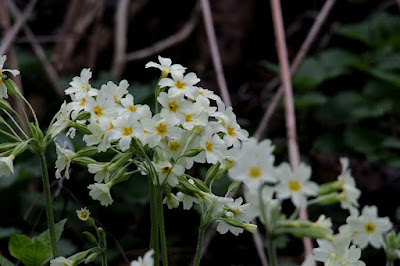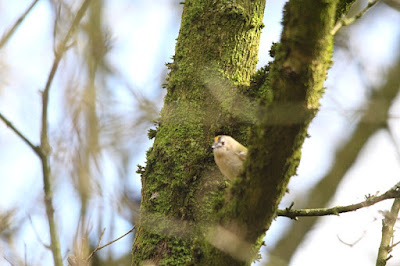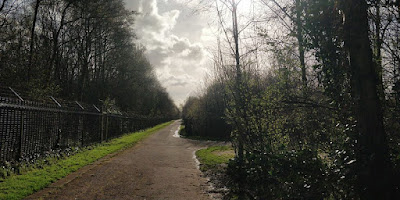 |
| Mediterranean gulls, Martin Mere |
It was one of those mornings where the sensible person would be finding themselves a nice cosy corner with a pot of tea and a pile of Harold Hare comics. So it was I got the Southport train at Victoria and headed off for New Lane. The train into Manchester no longer stopping at Deansgate is a pain (it's part of the effort to ease congestion at Castlefield Junction now there's no hope of diverting traffic via Mayfield Station or HS2) but I managed to trot over to St Peter's Square in good time for a tram to Victoria and the train behaved impeccably.
Along the way there was the expected woodpigeons and corvids and nearly every station had its blackbird. I arrived at New Lane and despite the drizzly weather decided to go the long way to Martin Mere via the reedbed walk to see what was about on the sewage works, tempted by the black-headed gulls wheeling round the station. It had become one of those heavy, muggy days that seem to sap the energy. Once every so often a welcome breeze would blow a restorative but they were just brief promises.
I'd only got as far as the telegraph pole at the corner of the first field when a hare toddled through the woodpigeons feeding in the stubble.
 |
 |
 |
| Brown hare, Martin Mere |
The sewage works were busy with black-headed gulls and oystercatchers and very thin on pied wagtails. All the meadow pipits were out on the fields with more gulls, woodpigeons and a flock of thirty-odd stock doves. Chiffchaffs sang in the hawthorns along the line, it can't be long now before they're joined by whitethroats.
The field across the railway line was gratifyingly full of skylarks and their song against a background of honking geese on the mere. A cacophony of caws and shrieks heralded the arrival of a marsh harrier over one of the pools and the objection to it by gulls, crows and jackdaws. A stonechat was holding territory on the corner of the path where the old shed has fallen down.
 |
| Martin Mere |
I joined the path along the perimeter of the reedbeds. It was noisy with distant geese and fairly quiet with hedgerow birds: a few robins, dunnocks and wrens sang and here and there a chiffchaff would sing in the trees. I took a diversion to see what might be feeding on the fence by the sewage works. The clouds of midges were largely unmolested, a couple of wrens were more intent on foraging in the elder bushes and a couple of reed buntings were busy singing. There's a tiny patch of reeds and brambles in a corner by the path that's about as big as a table cloth but still hosted a singing Cetti's warbler.
As I walked around the open reedbed there were a couple more Cetti's and the geese — Canada and greylag — made themselves known. Any hopes of adding any warblers to the year list were in vain.
 |
| Martin Mere, joining the path to Fish Lane |
For some reason there were fifty or more shelducks on the field by the path to Fish Lane, together with a dozen or so each of Canada geese, greylags and mallards. The path was atrocious so I had to apologise for walking to close to the wildfowl when I had to give in and walk the field margin. A pair of courting buzzards were escorted away from Martin Mere by a crowd of angry crows and black-headed gulls.
 |
| Black-headed gulls, Martin Mere |
Martin Mere was heaving with black-headed gulls. Most were just starting to negotiate nesting places though on at least one island they were already settled down at two stretched neck intervals just out of reach of neighbours' pecks.
It was hard work finding much that wasn't a black-headed gull or a mallard. A few cormorants loafed on the corner of one of the rafts and a handful of shelducks drifted about. All the waders were in the distance on the far side of the mere: a couple of dozen black-tailed godwits, mostly in their Summer gingers, a handful of avocets and rather a lot of oystercatchers. There were also a few wigeon and teal over there together with a couple of whooper swans and a handful of pink-footed geese. I scanned round the gulls to make sure they really were all black-headed and found a pair of Mediterranean gulls.
 |
| Mediterranean gulls and black-headed gulls, Martin Mere |
There were reed buntings on the feeders by the Raine's Observatory but though I could hear tree sparrows I was blowed if I could see them. I might have been hearing them from their nest boxes, there's a couple of dozen of them in the trees round here.
 |
| Martin Mere, the path to the Kingfisher and Ron Barker hides |
I wandered down to the Kingfisher Hide where the feeders were busy with greenfinches and reed buntings and the bushes busy with blue tits, great tits and chaffinches. A blackcap sang from the undergrowth and a cock linnet sang from the top of one of the hawthorns.
 |
| Oxlips, Martin Mere |
There was plenty on at the Rob Barker Hide, all of it distant. Three cattle egrets hobnobbed with the longhorn cattle a couple of fields away. Avocets, teal and shovelers loafed on the islands or fed in the distant shallows of the pools. A handful of wigeon grazed with the Canada geese on the banks and a heron patrolled the reed margins. A female marsh harrier made a cameo appearance and was roundly ignored by everything bar a couple of reed buntings.
As I strolled back the weather started to clear and I began to feel distinctly overdressed.
 |
| Common gull, Martin Mere |
 |
| Shelduck, Martin Mere |
I had a look at the mere from the screens where the Swan Link Hide used to be and found a common gull amongst the black-headed gulls.
The feeders on the Janet Keer Hide were dominated by greenfinches and goldfinches though a couple of tree sparrows managed to slip a few times. Down on the ground a couple of rats were constantly bullied off the fallen seed by mallards and moorhens.
 |
| The Harrier Hide |
 |
| Harrier Hide interior |
The final stage was a visit to the Harrier Hide. It looks great but I think it's pretty lousy as a hide — there's a lot of unusable space and it's very uncomfortable. On the plus side it overlooks a big pool on the reedbeds that attracts a different crowd to the mere, particularly diving birds such as pochards, tufted ducks and grebes. No sign of any grebes today but the pochards and tufties were there.
 |
| Tarlscough Lane |
As I left Martin Mere the flock of pink-feet feeding on the field across the road rose and fell in the distance. The change of angle as I walked down the road let me see them over the rise in the field and as far as I could tell they were all pink-feet. I walked down into Burscough Bridge hoping to see partridges or corn buntings along the way but having no luck at all. The corn bunting population round here definitely seems to have fallen, it wasn't so long ago I could guarantee three or four singing birds between Curlew Lane and Burscough.
 |
| On Red Cat Lane |
For all that I hadn't walked all that far, perhaps six miles, I felt tired by the time I just missed the train at Burscough Bridge and was glad of the opportunity to sit down and watch the goings-on in the rookery for twenty minutes. A grey partridge I spotted in a field near Hoscar kept the year list ticking over.












































